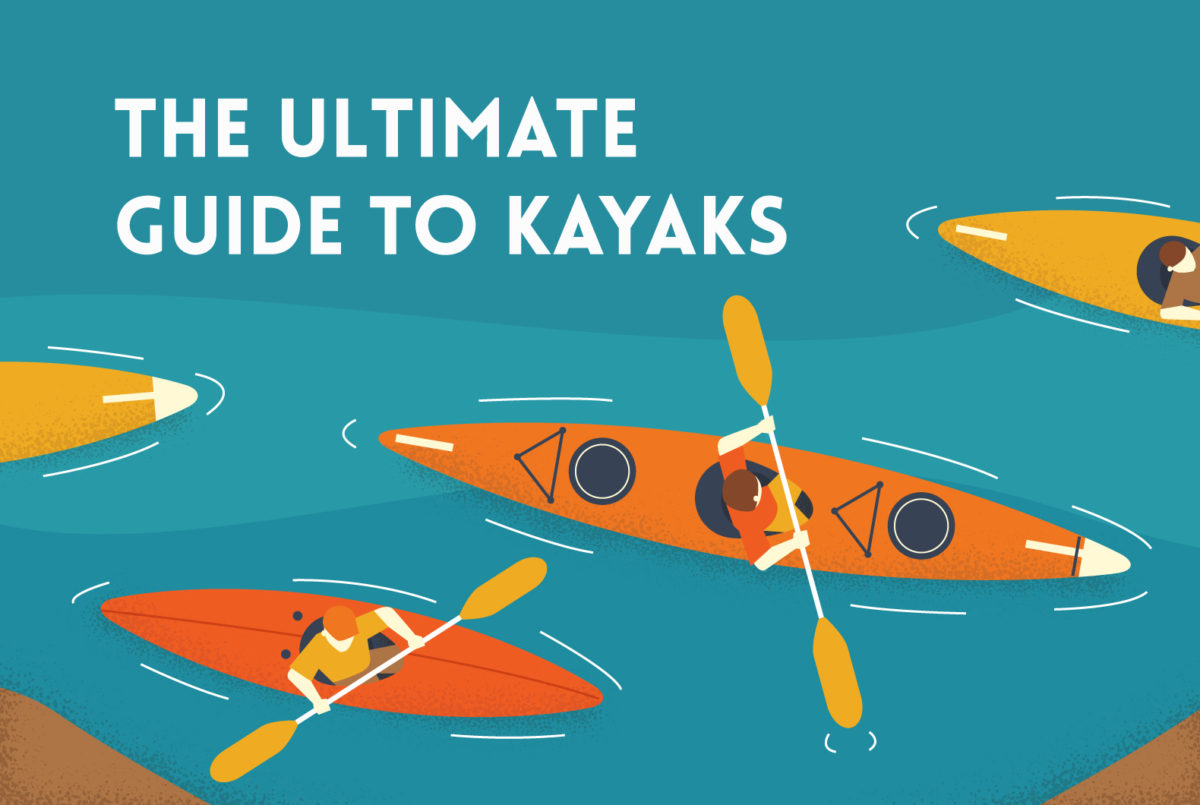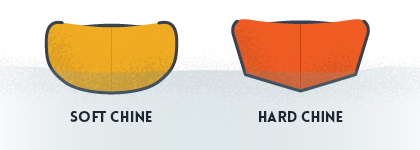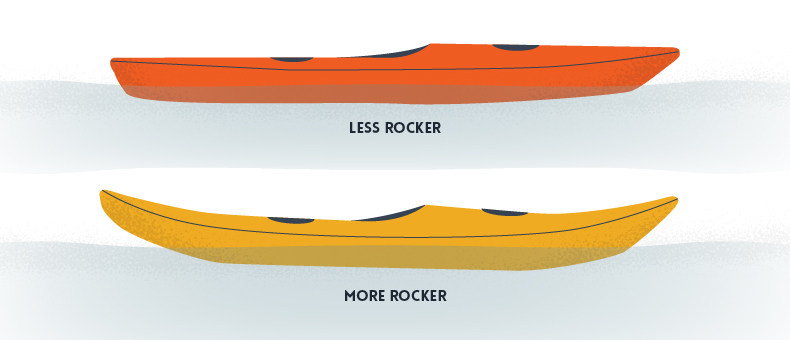

This article was written by Connor, one of our founding editors. Connor is a full-time travel and lifestyle photographer with extensive experience in the outdoors industry.
At its most basic, a kayak is a mode of transport and a way to hunt more easily. It allows you to get from one place to the other. It really is as simple as that.
These days, however, kayaking is far more than about just getting somewhere. The journey is equally as important, not just in kayaking, but in all walks of life. Kayaking has transformed from being a mode of transport to a sport which millions of people enjoy every day.
The possibilities and variations are endless in this sport, meaning you can enjoy it for being a relaxing recreational activity or alternatively, you can take it more seriously and even possibly compete in the likes of whitewater competitions.
Kayaking is a sport for thrill-seekers, yet catering to those who like to wind down and watch the crazy world go past them.

Due to the fact that there are many variations of the sport, there is plenty of variety when it comes to choosing a kayak. The main aspect you should consider when looking at kayaks is what your primary intended use will be. Ultimately, this will dictate which kayak you will go for.
One of the most popular options to go for is a recreation kayak because it is designed for novices and hobbyists. They are easier to use and offer a good amount of stability, which is exactly what you want when you’re just starting out or taking the family out for the day.
Recreational kayaks are ideal for day trips and usually have a small storage compartment which is suitable for this type of activity. Having said that, some recreational kayaks have larger storage compartments, making them suitable for multi-day trips.
The downside to this kind of kayak is that it is on the heavy side for transporting and for sorting out if you flip it. Additionally, they aren’t as good at staying in a straight line as some other kayaks.
Both of these types of kayaks come with their own advantages. Sit-on-top kayaks are far more stable, offer more space for storage (and yourself), and are usually easier for clambering into if you find yourself in the water.
The downside to a sit on kayak is that you will almost certainly get wetter than if you use a sit-in. These are ideal for use for families because they’re great to use for jumping in and out of the water.
Sit-in kayaks are generally warmer because they shelter more of your body from the wind. Furthermore, if you wish to stay drier, then a sit-in is your better option. This is handy if the water is colder or if you just don’t fancy getting as wet! The downside? Getting in and out of a sit-in is a bit trickier and they can be harder to sort out if you flip them because it will fill with water.
Touring kayaks are also known as sea kayaks and they are ideal for longer day trips or even multi-day trips. They are usually pretty stable and can handle rougher water, but are not designed for white water.
Although they are often called sea kayaks, they are certainly not limited to use in the ocean. Touring kayaks can be used on all sorts of waters because of their versatility. Granted, they’ll set you back a bit more than recreational kayaks.
Due to the fact they are designed for longer trips, touring kayaks will have more space for storage and even have sealed hatches. Often, between 12 and 17 feet long, these kayaks are well shaped to handle rougher water and waves. The cockpits are a bit more restricting because they are built with efficiency in mind and can also be used with a spray skirt.
Touring kayaks often feature a skeg, which is a fin at the rear underside of the kayak. This can be controlled by the paddler, who can choose how much of the skeg is in the water. The idea of the skeg is so that you can keep good directional control, allowing you to paddle in a straighter line more easily. They do make turning harder, though, so be sure to bring it up when you need to turn.
Often called snap-on, snap together, or folding kayaks, these are designed for ease of transportation. They are very easy to disassemble and are ideal for those looking to do a combination of backpacking and kayaking.
Generally, modular kayaks will break down into either two or three pieces, roughly to the size of a backpack. Due to the fact they’re designed to be disassembled, they’re not as good at handling rougher water.
Some modular kayaks allow you to construct them in such a way that they can be used either singularly or as a tandem. Most come as sit on, however, there are some which are available as sit-in kayaks.
Similarly, inflatable kayaks are also built for ease of transportation. They can be compressed to a small size which makes them incredibly popular for those who enjoy packrafting (a combination of backpacking and kayaking).
Inflatable kayaks are far more durable than you would think and are not designed to simply be a fun toy. They come in different forms, such as sit on, sit in, and self-bailing.
Inflatables aren’t as efficient as other kayaks, which means that it is harder to paddle through the water. That said, they tend to be highly durable and very lightweight for carrying around with you.
Specifically designed with fishers in mind, these kayaks come will all the features you would need for your trips, such as a rod holder, storage space and some even come with tackle boxes built-in.
Most anglers opt for a sit-on kayak because it offers more room to move and added stability for handling fish and casting. A sit-in kayak might be the preferred option for moving water due to the fact it is lighter and you will remain drier than in a sit-on kayak.
When choosing a fishing kayak, you should consider how much storage space you will need. This can differ from person to person or depending on the type of trip you’re doing. It would be a pain to not be able to easily fit everything you need with you.
As you will be aware, most kayaks are generally paddle-powered but you can in fact choose a pedal-powered fishing kayak. This can be extremely useful for freeing up your hands when handling fish or your rod.
As the name suggests, this is specifically designed for use in whitewater, coming in at generally between 4 and 10 feet long. Whitewater kayaking can provide the paddler with a good dose of adrenaline and because of the nature of the sport, a durable device is required.
Whitewater kayaks can take impact well and aren’t designed with speed in mind due to the fact that this comes naturally from the flow of the water. These kayaks are mostly shorter in order to improve maneuverability so that you can handle your direction and avoid objects with ease.
They come in all sorts of variations and you should choose one depending on your style and intended use. For example, some people choose a freestyle kayak because they enjoy doing tricks and need something they can throw around more easily. Additionally, someone who is looking for a bit more speed may choose a longer boat, possibly at 9+ feet.
A play boat is a variation of a whitewater kayak that is intended for surfing waves and performing tricks. There is far less volume at the front and back of the kayak, allowing you much more control. However, it does mean you will need more experience to be able to handle it properly.
The planing hull on play boats is generally very flat which allows it to sit on the water better when moving. It also means that the kayak can spin around a central point and you will have more control over it.
These are much higher volume than play boats, meaning that the boat won’t submerge and will surface quickly. You can carve well on a creek boat due to the small edges or “chines” along the bottom of the boat.

One of the key things to remember when paying attention to the size and design of a kayak is that you are always making a compromise and trading something for another. For example, when you choose speed, you’re likely to sacrifice stability. When you choose directional stability (going in a straight line), you’re likely to sacrifice maneuverability.
There are two types of stability when it comes to kayaking and they are referred to as “primary” and “secondary” stability. The design and shape of a kayak can affect how it handles both.
Primary stability is used to describe a kayak’s capability of handling flat water. Conversely, secondary stability refers to how stable a kayak remains when it is rocked, typically on choppier water like the ocean.
Kayaks are designed with these two in mind and you will usually see something like a touring kayak having better secondary stability, whereas a recreational kayak will have better primary stability.
Primarily, the length of the kayak will dictate speed and maneuverability. Due to the fact kayaks are made in a variety of ways, there are no strict rules which are always 100% true. That’s why we’ll stick to general terms when explaining this section.
Typically, the longer the kayak, the faster it will be. The perfect example of this is a sea or touring kayak, where maneuverability isn’t as crucial, but directional stability and speed are important. Kayaks that are longer have a longer waterline and this makes it much easier to stay in a straight line and glide through the water faster.
Recreational and whitewater kayaks, for example, are typically shorter and therefore will provide you with more maneuverability but will not be as speedy or maintain directional stability as well. That said, recreational kayaks, being slightly longer than whitewater, will offer more stability but slightly less maneuverability.
Recreational kayaks are between 9 and 14 feet
Day touring kayaks are between 9 and 16 feet
Multi-day/sea kayaks are between 13 and 19 feet
Fishing kayaks are between 9 and 16 feet
Whitewater kayaks are between 3 and 6 feet
Inflatable kayaks are between 9 and 16 feet
Sit on top kayaks are between 9 and 16 feet
The hull of a kayak refers to the shape of its bottom. There are four main hull types on kayaks and each can affect the way you paddle.

As you can guess from the name, the edges of this type of hull are rounded and are typically best used in the ocean or a running river. Rounded hulls offer more maneuverability and better stability in choppier water rather than on flat water.
V-shaped hulls are excellent for cutting through the water efficiently and staying in a straight line. The compromise is that they are poorer in terms of maneuverability. Although fast, they’re generally not as stable in rocky conditions compared to rounded hulls. That said, they will feel better on flat water.
Flat hulls are known as a bit of an all-rounder. They’ve got speed on their side, are relatively easy to handle, and they boast good stability in calm conditions. Flat hulls are good for beginner kayakers because of all-round stability and maneuverability. Fishers also like to opt for this type of kayak for the same reasons.
This type of hull is designed for maximum stability on both flat and rough water but does compromise maneuverability as a result of this. Tracking (staying in a straight line) is good with a pontoon hull, but they don’t offer a lot of speed for the paddler.
The chine on a kayak refers to where the side of the kayak meets the bottom of the hull. There’s endless potential for different types of chines to exist however, to explain it effectively, we will talk about the two extremes: hard and soft chines.

A soft chine is more rounded and, for that reason, it provides more stability on choppy water and offers good speed. As a consequence, soft chines won’t feel as stable on flat water.
A hard chine is more angular and offers better primary stability. Additionally, hard chines make it easier to stay in a straight line, and because of the hard edge, “surfing” performance is generally improved.

The rocker of a kayak refers to the curvature of the hull going from the bow (front) to the stern (back). The greater the curve, the better the maneuverability because less of the kayak is sitting in the water and therefore it faces less resistance.
Due to the lack of resistance, a kayak with more rocker will not track as well. It then makes sense that a kayak with very little or no rocker is far better at staying in a straight line but harder to turn.
Often, if a kayak has a high degree of rocker, the paddler will either use a skeg or rudder. Essentially, these are fins that aid the directional stability of a kayak. The difference between a skeg and a rudder is that a rudder’s side to side movement can be controlled. A skeg is fixed to the stern keel of the kayak and cannot be controlled from side to side.
In order to deal with a variety of conditions and uses, kayaks should be light and withstand impact well without damage.
The material a kayak is made from affects its durability, cost, strength, and weight. Primarily, there are five types of materials kayaks are built from, which we will take a look at below.
Polyethylene, the material used in shopping bags, is probably the cheapest you can get for kayaks and is also one of the heaviest. Due to how cheap it is, it is one of the most popular choices for kayakers at the moment.
Additionally, polyethylene handles bumps well because of its flexibility, meaning it is less likely to dent or crack but it can be scratched more easily by sharp rocks. Although modern kayaks are protected better from UV damage, its flexibility can let it down if it is not stored or looked after properly because it is prone to warping in warm temperatures and under direct sunlight.
Fiberglass (or fiber-reinforced plastic) kayaks are incredibly light and strong but are typically found in the higher price bracket. Although fiberglass is stiff, it means that it doesn’t handle impacts as well and can be more prone to damage. Fortunately, though, it is relatively easy to repair if you know how to. Two of the main disadvantages of using fiberglass are that they are costly and heavy.
This is another relatively cheap material for kayaks. Due to their construction, they tend to be scratch resistant, light, and have high maneuverability. Although it is slightly more expensive than polyethylene, it is lighter and will go faster in the water.
Similar to fiberglass, polycarbonate kayaks have a shiny finish to them which makes them attractive and they aren’t too hard to repair if damaged. Opt for this material if you want a kayak that is still at the lower end of the price bracket but performs better than polyethylene.
You can’t get too much more traditional than wood. If you build your own, wood can be a very cheap way to get it done. However, if you are having the kayak custom made, then it is incredibly costly. The benefit to using a wood kayak is that it’s surprisingly lightweight, strong, and isn’t too complicated to repair.
Coming under the ‘composite’ category, like fiberglass, kevlar is a high-cost material, but strong and lightweight in comparison. Kevlar on its own can sometimes be too flexible, so many people opt for a kevlar/carbon combination which helps to reinforce and strengthen the boat. One of the major downsides is that, if damaged, kevlar can be a nightmare to repair on your own.
As well as just the kayak, there are lots of other extras you need to consider, like paddles, a spray skirt, flotation devices (PFD), a roof rack, a bilge pump (to bail water), and a cockpit cover just to name a few items.
Some of the extras are optional depending on what your trip is like and your personal preference. Others, however, should be considered as vital pieces for any kayaker. For example, you can’t leave without your paddle and you should never leave without a PFD for each person in your party.
For each of the ‘extras’ we mentioned above, there are many varieties to choose from and a lot of it can depend on how you intend to use it and your type of kayak. We’ve actually created a kayaker’s essential packing list which contains nearly everything you’d need for a day trip.